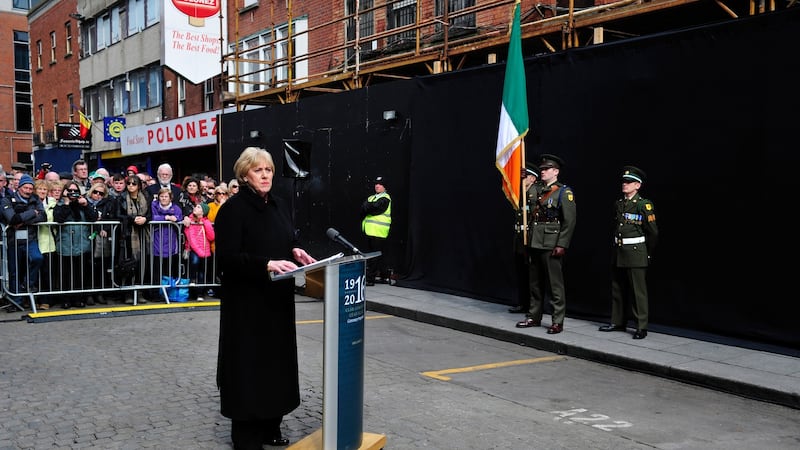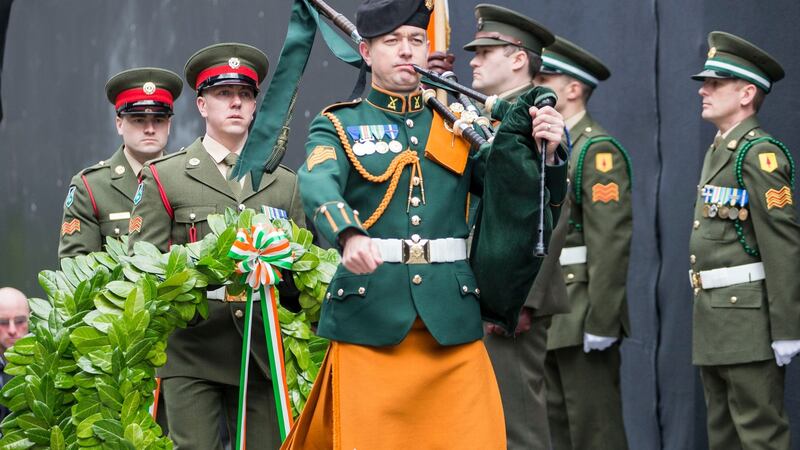Moore Street, in the shadow of the GPO - the scene of tumult and tragedy in Easter Week 1916, and now a scene of confrontation once again.
On Easter Monday, the street described as our "last extant 1916 battlefield" by James Connolly's great-grandson, James Connolly Heron, became a battlefield in more ways than one.
As one of seven sites chosen for simultaneous wreath-laying ceremonies at 1.15pm, to mark the first shots from the GPO on Easter Monday, little Moore Street had promised to be one of the more poignant, intimate State commemorations.


Instead, the site of the last meeting of the Military Council of the newly proclaimed Irish Republic, the place where Patrick Pearse issued the surrender, descended into a very modern battle, as speakers led by Minister for Heritage Heather Humphreys struggled to make themselves heard over a cacophony of chanting and whistling from about 20 protesters of the Save Moore Street Campaign 2016.
From behind the high, black-out barriers, the chants of “Humphreys Out” and “Shame Shame Shame on you” effectively drowned out the Minister’s speech and readings by Army officers.
Performed impeccably
Roars of “traitor to the people” accompanied the Minister’s invitation to two children of 1916 relatives, Dylan Murphy and Orna Ni Dhalaigh, to lay wreaths. They performed their roles impeccably.
One hundred years ago, Orna's great grandfather, Frank Henderson, made it through the smoke from the GPO with his brother and took refuge in a house on this street.
Dylan, a 12-year-old great-great-great-grandnephew of Nurse Elizabeth O'Farrell - who treated the wounded here and carried the surrender to General Lowe - said afterwards that the protesters' noise had made him a bit nervous but he understood it was coming from "a few disappointed, angry people. I knew it was aimed at [the Minister]".
The same people appeared anything but disappointed as they posed for photographs later, some dapper in their period-ish clothes sourced from charity shops or from an obliging, elderly neighbour willing to loan out a 1970s Army uniform or an old suit.
Some of the campaigners had lost jobs during their 38-day campaign to stop work on the Moore Street site, said Niamh McDonald, in blue tweed.
But had they not been reassured by the favourable High Court judgment? "We're very happy about that," said Eamon McGrath, "but we are NOT happy with Heather Humphreys coming down to lay wreaths here - like she cares." "Hypocrite," said Billy Duggan. "She said she intends to appeal that decision, and then they ask her to lay a wreath here...", said McDonald.
But was this an appropriate occasion to stage such a noisy protest? They had no view of the proceedings and so claim they had no way of knowing what was going on. “The INTENTION was only to do it while Heather Humphreys was speaking,” said McDonald.
"We went silent when we understood what was going on, but we couldn't hear a lot of it, probably because of the racket we were kinda making too," said Alan Driscoll, in the Army uniform.
They were there only to “highlight the hypocrisy” of Heather Humphreys. “We didn’t mean to offend others...” said McDonald.
There were 1916 relatives towards the front “also shouting at Humphreys”, they pointed out.
Proinsias O’Rathaille was to be found at the spot just around the corner where his grandfather, The O’Rahilly, was left to die in an alleyway in 1916.
‘I didn’t heckle’
A prominent member of the Save Moore Street Campaign, he said genially: “I didn’t heckle the Minister. I wasn’t at the State event. We organised our own.”
His event was also attended by James Connolly Heron, who has issues with The O’Rahilly’s omission from the government programme which still managed to find space for British army personnel - “ALL who died...”, he said witheringly.
Perhaps he was cross that no space had been created for them at the main event? There had been no relatives there apart from the two children and their parents, plus the Minister, Army participants, department officials, media and some people with mobility problems.
“No, we didn’t expect an invitation. But it would be nice to get recognition. It was the campaigners who saved the street, not the Minister who was here laying a wreath.”
Back in the crowd, Elizabeth O’Connor Bonass, who runs a little Irish pub in Maryland in the US, said her grandmother ran a stall on Moore Street for 40 years from the 1920s and that her uncle, John O’Rourke, was captured while fighting in Jacob’s.
She had signed all the Save Moore Street petitions online and readily admitted to some light heckling during the ceremony – “but only while the Minister was speaking. I don’t know why she was present – she fought to demolish this. I can’t believe she was here. And why was it roped off?”
Up the street, another branch of the O’Rahillys was out in strength. Maria McBrayer, a great granddaughter of The O’Rahilly, now living in North Carolina, was present with her mother Roisin, her husband Frank, and son and daughter.
They found the proceedings a bit “confusing in the shouting”, but recorded it to play later. The protest, said Frank, “was rude and disrespectful. We were here to honour a situation 100 years ago and here were people throwing today’s politics into it”. But they hope the court judgment holds.
The Minister in a statement later said “the protesters showed utter disrespect for those relatives” who had gathered for the wreath-laying in Moore Street in honour of those who fought and died for the country, as well as for the two children who were laying a wreath.
“The ceremony today was designed to be solemn and respectful. I find it very disappointing that a small group of protesters would seek to disrupt it in such a disrespectful way,” she said.
Up near the front of the crowd, Joan Guinan (nee Dowdall) (85), was surrounded by attentive children and grandchildren, and getting “a bit emotional”.
Born and raised in one of the disputed Moore Street houses, she can name the occupants of each one in her time.
“From the time I was small, I KNEW the [rebels] all came through our houses. There was a hole in the wall. It was filled in and covered by wallpaper but to me the hole was always there”.










